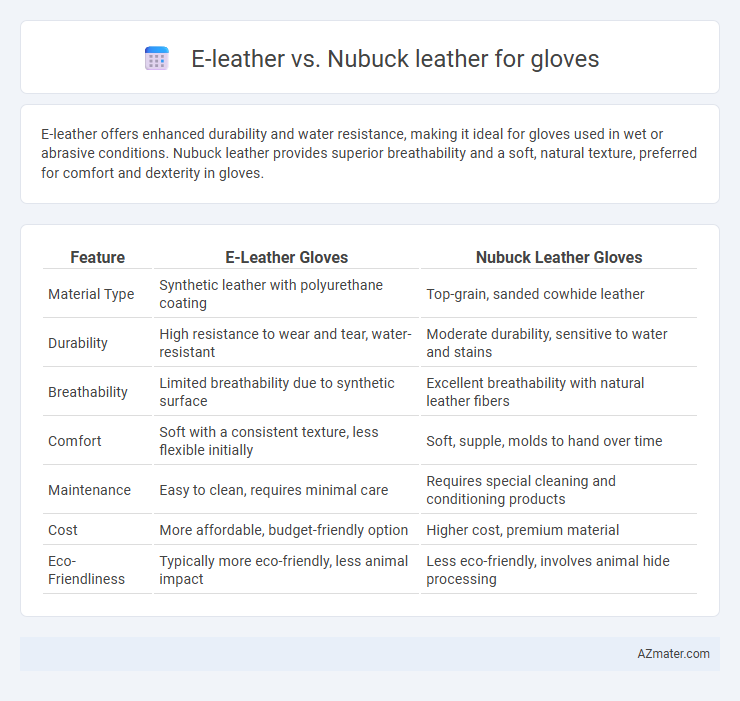E-leather offers enhanced durability and water resistance, making it ideal for gloves used in wet or abrasive conditions. Nubuck leather provides superior breathability and a soft, natural texture, preferred for comfort and dexterity in gloves.
Table of Comparison
| Feature | E-Leather Gloves | Nubuck Leather Gloves |
|---|---|---|
| Material Type | Synthetic leather with polyurethane coating | Top-grain, sanded cowhide leather |
| Durability | High resistance to wear and tear, water-resistant | Moderate durability, sensitive to water and stains |
| Breathability | Limited breathability due to synthetic surface | Excellent breathability with natural leather fibers |
| Comfort | Soft with a consistent texture, less flexible initially | Soft, supple, molds to hand over time |
| Maintenance | Easy to clean, requires minimal care | Requires special cleaning and conditioning products |
| Cost | More affordable, budget-friendly option | Higher cost, premium material |
| Eco-Friendliness | Typically more eco-friendly, less animal impact | Less eco-friendly, involves animal hide processing |
Introduction to E-Leather and Nubuck Leather
E-leather, or engineered leather, is a synthetic material designed to mimic the look and feel of natural leather while offering enhanced durability and water resistance, making it ideal for gloves used in various weather conditions. Nubuck leather is a type of top-grain cattle leather that has been buffed on the grain side, resulting in a velvety, soft texture that provides superior breathability and comfort. Both materials serve distinct purposes in glove manufacturing, with e-leather excelling in toughness and maintenance, while nubuck delivers premium softness and a luxurious appearance.
What is E-Leather? Definition and Features
E-leather, or eco-leather, is a synthetic leather made from polyurethane or other environmentally friendly materials designed to mimic the texture and durability of genuine leather. It is water-resistant, easy to clean, and often more affordable than natural leather, offering enhanced flexibility and breathability for gloves. Unlike Nubuck leather, which is made from top-grain cattle hide with a soft, brushed surface, E-leather provides consistent quality and greater resistance to stains and wear.
What is Nubuck Leather? Definition and Features
Nubuck leather is a top-grain cattle hide that has been sanded or buffed on the grain side to create a velvet-like surface with a soft, suede-like texture. It boasts superior breathability and durability, making it a preferred material for gloves that require both comfort and resilience. Nubuck's fine grain and natural appearance differentiate it from synthetic E-leather, providing a premium tactile experience and enhanced grip.
Durability Comparison: E-Leather vs Nubuck
E-leather gloves offer superior durability compared to nubuck leather, as E-leather is engineered with synthetic fibers that resist wear, moisture, and staining more effectively. Nubuck leather, made from top-grain cattle hide with a buffed surface, is prone to scuffing and water damage, requiring more maintenance to preserve its appearance. For intensive use, E-leather gloves maintain structural integrity longer, making them ideal for high-impact activities.
Comfort and Fit: Which Leather Performs Better in Gloves?
E-leather offers superior stretch and breathability, providing a snug and flexible fit that adapts well to hand movements, enhancing overall comfort during extended wear. Nubuck leather, known for its soft, velvety texture, delivers excellent comfort but can be stiffer initially, requiring a break-in period to achieve optimal fit and flexibility. For gloves prioritizing immediate comfort and adaptive fit, E-leather generally outperforms Nubuck leather, especially in active or prolonged use scenarios.
Maintenance and Care Requirements
E-leather gloves require minimal maintenance compared to Nubuck leather, as they resist water and stains, enabling easy cleaning with a damp cloth. Nubuck leather demands regular brushing with a suede brush and specialized cleaners to preserve its soft texture and prevent dirt buildup. Proper storage in a cool, dry place is essential for both types to maintain durability and appearance over time.
Environmental Impact: Sustainability of E-Leather and Nubuck
E-leather is often considered more sustainable than nubuck leather due to its production process, which uses synthetic materials that reduce the demand for animal hides and cut down deforestation. Nubuck leather, derived from the outer layer of animal hides, involves resource-intensive livestock farming with higher greenhouse gas emissions and water usage. E-leather's potential for recyclability and lower chemical treatments contribute to a smaller environmental footprint compared to the traditional tanning processes required for nubuck leather gloves.
Cost Analysis: Price Differences Explained
E-leather gloves typically cost less than nubuck leather gloves due to lower raw material and production expenses, making them a budget-friendly option without sacrificing style. Nubuck leather, derived from top-grain cowhide with a soft, velvety finish, demands more intensive processing and higher-quality hides, driving up the price considerably. Cost differences reflect durability, texture, and manufacturing complexity, with nubuck offering premium quality at a higher investment compared to the synthetic makeup of e-leather.
Style and Aesthetics: Visual and Textural Differences
E-leather gloves offer a smooth, consistent surface with a sleek, polished appearance, ideal for modern and minimalist styles, while Nubuck leather gloves display a soft, velvety texture with a matte finish, providing a rich, natural aesthetic. The fine nap in Nubuck creates subtle variations in shading and depth, enhancing tactile appeal and visual warmth compared to the uniform veneer of E-leather. Both materials maintain stylish versatility, but Nubuck's handcrafted look often suits vintage or rugged fashion, whereas E-leather aligns with contemporary, streamlined design.
Which Leather is Best for Gloves? Final Verdict
E-leather offers superior water resistance and easy maintenance, making it ideal for gloves used in wet or harsh environments. Nubuck leather provides exceptional breathability and a soft texture, enhancing comfort and dexterity for prolonged wear. For durability and practical everyday use, e-leather is best, while nubuck excels in premium, comfortable gloves requiring a natural feel.

Infographic: E-leather vs Nubuck leather for Glove
 azmater.com
azmater.com